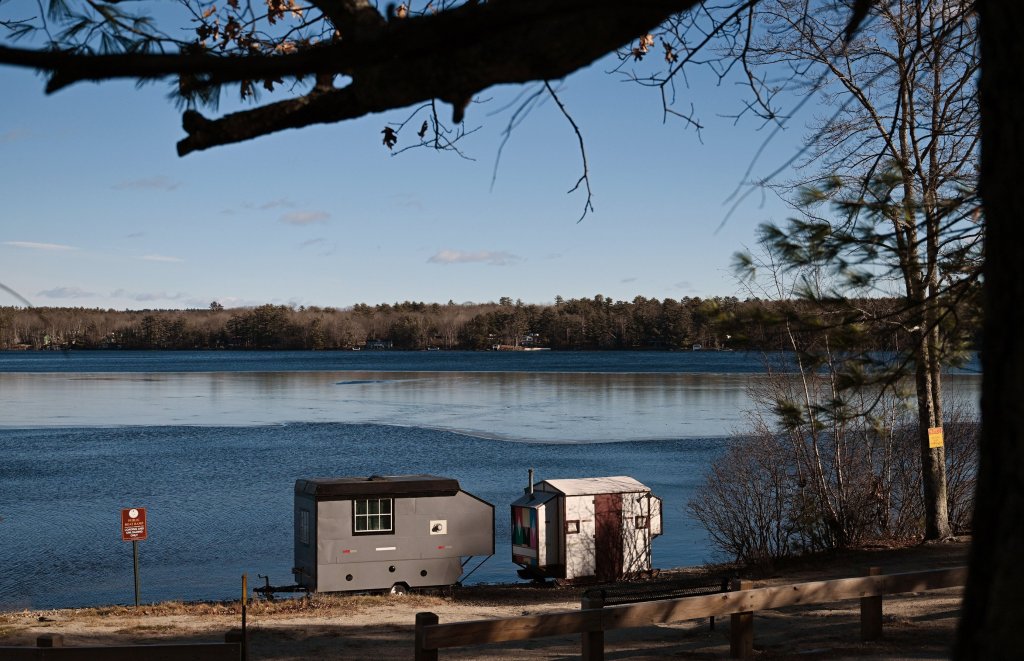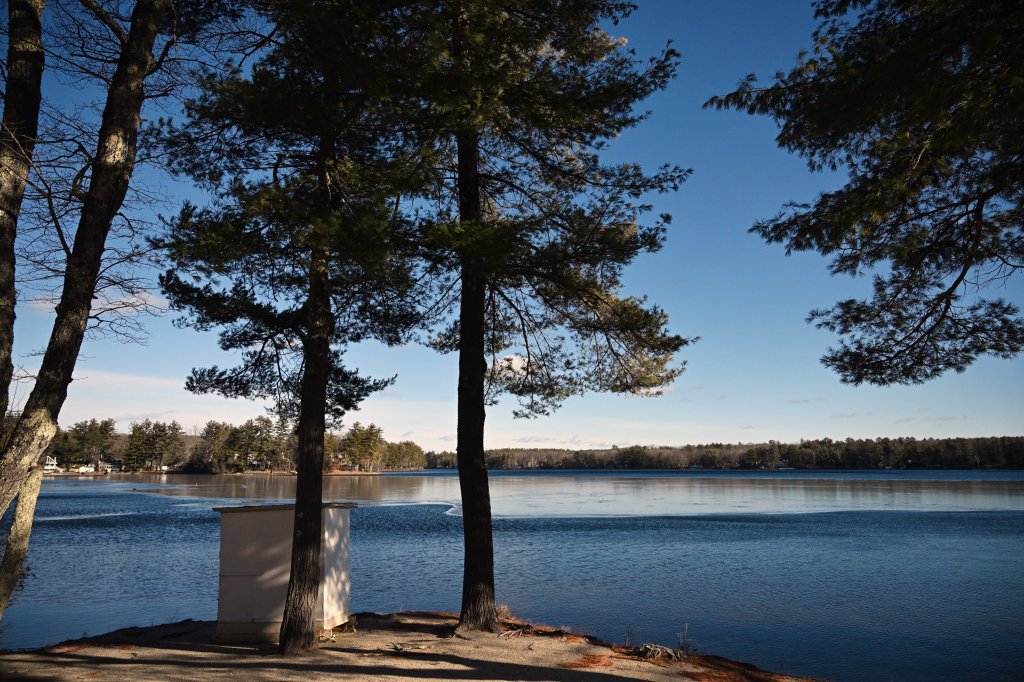Climate change chips away at Maine’s lake ice season
January 5, 2025

Ice shanties sit along the shore of Little Ossipee Lake in Waterboro on Friday. The lake is beginning to freeze but has open water in many spots. Shawn Patrick Ouellette/Portland Press Herald
Last winter, Salmon Lake was iced over for just 67 days. That’s the shortest ice season in the 34 years that retired Colby College professor Lenny Reich has recorded the freeze and thaw dates on a support beam in the basement of his lakeside home in Belgrade.
“In a few decades, there won’t be much ice at all, certainly not enough to safely fish or snowmobile,” he said. “The lack of winter ice only exacerbates warming because snow and ice reflect the sun, while open water absorbs sunlight, and as a rule, a hot lake is not a healthy lake.”
Maine lakes are warming two times as fast as the air around us, according to the Maine Climate Council. Since the 1980s, the lakes of northern New England have been warming, on average, about 1.4 degrees Fahrenheit per decade.
The blast of cold air that arrived late last week is expected to last through this week and help freeze over lakes and ponds that still have thin ice and, in many cases, open water. State officials warned residents last week to be careful and check ice thickness after people fell through thin ice, including a 68-year-old man who nearly died on New Years Day in Franklin County.
Salmon Lake — which last winter iced over Jan. 8 and iced out on March 15, according to the support beam records in the basement of Reich’s home — offers a peek at the rapidly warmer future that awaits Maine’s ponds, lakes and rivers.
Ice-in dates for Maine’s freshwater bodies are hard to come by — it can be hard to detect when the final freeze occurs — and ice-in doesn’t mean it’s solid enough to safely skate or fish. But Maine has a century-old record of ice-out dates that show freshwater thaws are happening earlier, said state climatologist Sean Birkel.
“Ice out on Maine lakes is occurring 1-2 weeks earlier on average now compared to what was typical in the 1970s,” Birkel said. Given Maine’s rising fall temperatures, he noted, it’s likely that ice-ins are happening later, too, even if there is no broad historical data. “November and December have both warmed and many have observed lakes freezing later.”
There can be considerable variation across the state. The ice-out date for Acadia National Park’s Eagle Lake is only one day earlier than it was in 1960, while western Maine’s Worthley Pond is now thawing out 25 days earlier, according to the 2020 Maine’s Climate Future Report from the University of Maine.
Scientists first recorded this trend two decades ago. In 2002, two federal geologists combed newspaper reports to gather ice-out dates for 29 New England lakes and revealed they were happening between 9 and 16 days earlier than they did in 1850.
Averaging ice-out dates from Maine’s more than 300 ponds and lakes suggest the change is speeding up. Over the last 20 years, the median ice-out date has shrunk by 37 days, from April 16, 2005, to March 10, 2024, according to state and lake association data.
But again, lake-to-lake variation was high — the earliest ice-out in 2005 was April 7; the latest was May 6.

An ice shanty sits along the shore of Little Ossipee Lake in Waterboro on Friday. Shawn Patrick Ouellette/Portland Press Herald
Birkel said he would like the Maine Climate Office, which he oversees, to begin tracking ice season dates for Maine’s freshwater bodies. The Maine Climate Council has identified ice coverage data and the effects of ice decline on lake health, outdoor recreation and land value as a topic in need of more research.
Recording ice-out dates — or when a lake’s center is free of ice — is a custom upheld by hundreds of people across Maine. Ice-out dates have long-inspired bets and raffles. Even the state logs it. But today the dates represent something altogether more serious: an indicator of climate change and lake health.
Ice-in data is sparse but slowly growing, mostly through citizen science observations recorded by people like Reich and maintained by local lake associations, the Maine Lakes Environmental Association or the Lake Stewards of Maine, which posts its ice-in and ice-out tracking data online.
That data is expected to come in handy. Winter is our fastest-warming season, up 5 degrees Fahrenheit from a century ago, according to the Maine Climate Council. The nighttime low temperatures that are so important to forming ice are rising fast, too. Overall, our winters are now about two weeks shorter.
Shorter, warmer winters cause higher air temperatures and bring rain instead of snow, both of which deter ice formation. In the past, scientists often dismissed freshwater ice trends as a concern for skaters and fishermen. But in recent years, they have come to recognize the important role it plays in lake health.
Less ice coverage and warmer waters increase summer stratification, which deprives the bottom waters of a pond or lake of oxygen, according to Ben Pieriels, Maine Lakes’ research director. Fish need oxygen; if there is not enough dissolved oxygen in the lake water, they die.
Warmer waters promote algae and vegetation growth, including invasive species that plague the lakes near Reich, and cyanobacteria, a type of blue-green algae that can quickly bloom in nutrient-rich waters that contain toxins that are dangerous and even fatal to wildlife, pets and people, Pieriels said.
Earlier ice-outs mean a longer open water season and longer periods of higher summer temperatures that can be stressful and even lethal for Maine’s coldwater fish, he said. Lake conditions are changing to favor warm water species to the detriment of smaller native species, such as rare minnows.
And then there’s the timing issue. If a water body freeze or thaw signals a changed date for the beginning or end of a food source, be it plant or animal, the wildlife that depend on that food may miss out on their proverbial supper just before hibernation, birthing or mating season.
Maine pond hockey players, backcountry skiers and ice fishers bemoaned poor ice conditions last winter, one of the warmest on record. As rescue crews know all too well, lake ice can be unsafe for weeks after a freeze and before a thaw, and unstable even during winter’s coldest months.
“Maine is known as a destination for winter sports, and if things continue the way they have been the past few years, it’s certainly going to have impacts,” Mark Latti, a Department of Inland Fisheries and Wildlife spokesman, told the Sun Journal in March. “Winter is a lot different now.”
While most people value its skating, fishing and snowmobiling benefits, a seasonal ice cap also protects the water below from shoreline runoff — less ice means less protection from chemicals, salt and nutrients in the runoff and declines in water quality.
The risk of declining ice coverage is real, but it shouldn’t be overstated: it’s only part of the threat posed by climate change, and that threat is dwarfed by the damage that can be caused by the runoff and septic system discharges created by lakeside development, according to state geologist Ryan Gordon.
For now, Reich will keep logging the ice-in and out dates in his basement (ice-in this year was Dec. 23), warning about the dangers of rampant energy consumption in the seasonal newsletter of the McGrath Pond-Salmon Lake Association, and driving to the State House to lobby for stronger lake protections.
“It’s time for everyone who cares about lakes and streams, forests and wetlands — and the creatures who inhabit them, including us — to do everything we can to slow climate change,” Reich wrote in the spring newsletter. “You could say that our lives, and theirs, depend on it.”
Search
RECENT PRESS RELEASES
Related Post


